Before [Elizabeth] had been three minutes in her own room, her mother followed her. “My dearest child,” she cried, “I can think of nothing else! Ten thousand a year, and very likely more! ‘Tis as good as a Lord! And a special licence! You must and shall be married by a special licence! But, my dearest love, tell me what dish Mr. Darcy is particularly fond of, that I may have it to-morrow.” – From Pride and Prejudice by Jane Austen
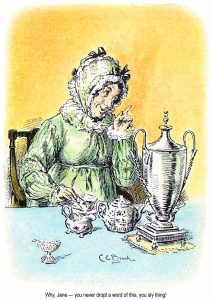
Lizzy, tired and with her mind elsewhere from the events of the day, that had included a long walk to Oak Mount with Darcy, spent in happy reflections on their prospects, and afterward making her parents acquainted with their attachment, only stared for a moment, and tried to think. “I can’t say that I know, Mama,” she said. “He seemed to like the dinner you gave him last time – did not he? So you are sure to please him again.”
“Oh, yes, that fat haunch of venison! And the soup, that was perfection, if I do say so. But you recollect he complimented the partridges particularly. It is hard to cook for someone so rich, to be sure. But Cook does very well, under my direction of course. I do not pretend to my table being any thing extraordinary; but good, plain food, with the best ingredients procurable, will please even the most fanciful appetite.”
“That is very true,” Elizabeth agreed, “and do not forget, Mr. Darcy is already prejudiced in our favor, as an engaged man ought to be.”
“Yes, but it would be a very dreadful thing if any of the dishes should go wrong, you know, Lizzy. And we have no pheasants to hand. I wonder if I can procure some grouse in the morning…”
“Good night, Mamma,” said Elizabeth and returned to her chamber.
The next day passed easily enough. Mrs. Bennet did not dare to say much to her intended son-in-law at breakfast, and spent most of the afternoon giving orders in the kitchen. Elizabeth and Darcy, Jane and Mr. Bingley, again enjoyed the lovely October weather as they walked about the countryside, the two couples sharing in their delight and mirth, in a walk ever afterward to be recalled in future years as one of the happiest of their lives.
They came in for dinner with good appetite; and found that Mrs. Bennet, her cook and helpers, had outdone themselves. At the first course, the long table was covered with luxurious food. At one end of the table was some brown soup; at the other, a duck ragout. An enormous pigeon pie was the centerpiece of all; and scattered artfully about were a dozen other platters, with a variety of delicacies, savoury and sweet. A potato pudding, calves’ feet jelly, beet root, veal and olives, and French bread. With the second remove, the empty pie-platter was taken away and replaced with a large whipped syllabub with preserves, while orange cheese cakes and apple loaf replaced the duck and veal.
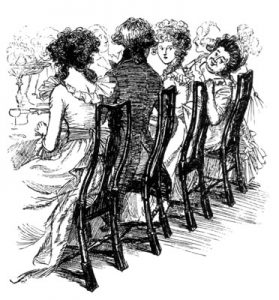
Mrs. Bennet did not venture to ask Mr. Darcy what he thought of her prodigious production, but was delighted that he was civil enough to request a second serving of the pigeon pie.
“And I,” cried Mr. Bingley, “will have some of that too, if it can be brought round.”
“I am so glad you gentlemen like our pigeon pie,” Mrs. Bennet beamed.
“Never tasted a better one, Mrs. Bennet – but to be sure, every thing on this table is so very good,” enthused Bingley. “Don’t you think so, Darcy?”
With a smile at Elizabeth, Darcy showed none of the sardonic pride that had been seen in other days, but warmly agreed, and even told Mrs. Bennet that he particularly enjoyed the bread, made in the true French fashion.
“Well, there!” Mrs. Bennet put down her fork and clasped her hands happily. “And you are a judge, Mr. Darcy – with real French cooks at Pemberley of your own, have you not?”
“Indeed we do,” he agreed, adding with a noble effort, “and your French bread is every bit as good as theirs.” Then he turned away and devoted himself to Elizabeth.
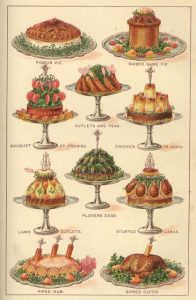
Mrs. Bennet did not care that he had ceased to speak to her. “There,” she whispered to Jane on her other side, “did you hear that? Only think! Our French bread as good as that at Pemberley!”
Jane smiled, and Mr. Bingley kindly told her that the entire meal was a triumph, and he felt that he could speak as an authority, and say that his friend thought the same. “Darcy does not enthuse,” he said, “it is not his nature; but I know him well enough to be able to tell that he was completely delighted.”
“Oh!” replied Mrs. Bennet, “and I am so delighted with him! The handsomest, most charming man that was ever seen in the world! Only think of Lizzy – ”
To prevent any public repetition of her mother’s “Ten thousand a year!” effusions, Jane gently interposed, “I am sure that Mr. Darcy enjoyed his dinner, Charles, but his happiness and delight come from another source, as well, I believe.”
Mr. Bingley looked at her glowing face with a rapturous smile. “To be sure, we are the two luckiest of men,” he said simply, and they all looked over at Mr. Darcy and Elizabeth, whose faces were both becomingly softened as they gazed into each other’s eyes, unaware of the rest of the company.
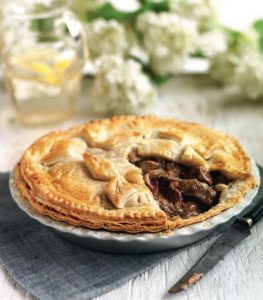
************************
Speaking of bread (not pigeon pie, sorry), during this confined period, many people have turned to baking. I’m not quite sure why, perhaps for comfort, or in a pioneer survivalist state of mind? I have not been exempt, and for the first time in my life, I actually baked a loaf of bread! It was surprisingly easy, and I had beginner’s luck, with the loaf turning out very well indeed. I felt quite at one with women of the past, and wondered if anything like my bread had ever been on Jane Austen’s table. Here is a bread recipe from Jane Austen’s day:
Sift a peck of the best white flour into a trough, make a cavity in the centre, and strain through a hair sieve a pint of good yeast and a pint of lukewarm water mixed together; mix up gently with this liquor some of the flour till of a light paste, set it in a warm place covered over to prove for an hour; then mix the whole with two quarts of lukewarm water and a little salt, knead it of a good stiffness, prove it an hour more, and knead it again; prove it another hour, mould it into loaves or batch two pieces together, and bake them in a brisk oven. A middling-sized loaf would require an hour and a half in baking.
Bread making was much more laborious in Austen’s day, but the ingredients in my loaf are much the same. This is the recipe I used, adapted from one of the most popular ever published by the New York Times:
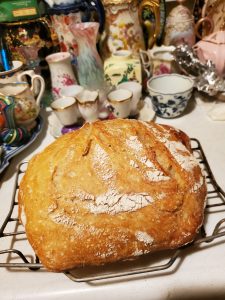
NO-KNEAD BREAD
INGREDIENTS
3 cups all-purpose or bread flour, more for dusting
¼ teaspoon instant yeast
1 ¼ teaspoons salt
Cornmeal or wheat bran as needed
PREPARATION
In a large bowl combine flour, yeast and salt. Add 1 5/8 cups water, and stir until blended; dough will be shaggy and sticky. Cover bowl with plastic wrap. Let dough rest at least 12 hours, preferably about 18, at warm room temperature, about 70 degrees.
Dough is ready when its surface is dotted with bubbles. Lightly flour a work surface and place dough on it; sprinkle it with a little more flour and fold it over on itself once or twice. Cover loosely with plastic wrap and let rest about 15 minutes.
Using just enough flour to keep dough from sticking to work surface or to your fingers, gently and quickly shape dough into a ball. Generously coat a cotton towel (not terry cloth) with flour, wheat bran or cornmeal; put dough seam side down on towel and dust with more flour, bran or cornmeal. Cover with another cotton towel and let rise for about 2 hours. When it is ready, dough will be more than double in size and will not readily spring back when poked with a finger.
At least a half-hour before dough is ready, heat oven to 450 degrees. Put a 6- to 8-quart heavy covered pot (cast iron, enamel, Pyrex or ceramic) in oven as it heats. When dough is ready, carefully remove pot from oven. Slide your hand under towel and turn dough over into pot, seam side up. Cover with lid and bake 30 minutes, then remove lid and bake another 15 to 30 minutes, until loaf is browned. Cool on a rack.
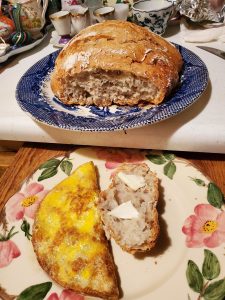

11 comments
Skip to comment form
Fortunately I no longer bake since my children left home as there doesn’t appear to be any flour in local shops!
The last time I baked bread was when there was a shortage in the seventies. There were queues outside all the bakeries and not enough to go round.
How on Earth did Mrs Bennet manage to provide all that food? I hope none of it went to waste? 😱
She made a special effort, Glynis! I’m sure nothing went to waste, though. They’d finish the next day.
I was lucky to find the flour for my bread!
Whenever people get worried about bad weather or in this case illness, they shop. The shelves are empty of bread, milk, and eggs. I have multiple health problems, and am caring for my 88 year old Mom, so going out is a BAD idea. I decided to leave the bread in the store for those who don’t know how to bake, or are busy caring for the sick. I’ve been baking bread since my teens, and just stepped up my production.
French bread! How lovely that Cook knows how to make it. It does sound like a great deal of work, especially without a KitchenAid, but so worth it.
https://juniesbaking.tumblr.com/post/614219496744517632/i-stocked-up-on-baking-supplies-since-we-were
I love to bake bread; unfortunately, it is only an occasional treat since the enticing aroma causes me to lose all sense of portion control.
And I must wonder along with Glynis, how did Mrs. Bennet set such a plentiful table? The number of dishes on the table are amazing to me. There must have been a large kitchen staff! Thanks for the interesting post. This month will be entertaining.
Well, Mrs. Bennet pulled out all the stops to impress her two prospective sons-in-law! Perhaps she called in help from elsewhere in the neighborhood.
This was a delightful post. Like Glynis, I had trouble finding flour anywhere for several weeks, let alone finding even a small bag of cornmeal. Now here in the southern US… to be without cornmeal is pretty serious business. We like our cornbread. And… you can forget about finding yeast. It has been over a month and I have not seen one package anywhere. My friend finally did her own sourdough starter so she could even make bread.
Your bread picture was really pretty and looked delicious. I loved the beautiful dishes in your pictures. I imagine many are antique.
I agree with Sandra, that must have been quite a table Mrs. Bennet spread… and apparently on short notice. Her kitchen must have been humming for 24 hrs. Did they even sleep? LOL! Thanks for sharing.
I was lucky to find flour when I did. J.W. Garrett! I love cornbread too, and ordered a bunch of Jiffy corn muffin boxes at start of all this. 🙂 Yeast I ordered from eBay, at a jacked-up price. My bread did come out well, it was beginner’s luck. The dishes are from thrift stores, I’m like a magpie!
Congratulations on the bread. It’s a tempermental thing! It’s a great recipe. I’ve made it before. The best thing to have with Jiffy cornbread (or any cornbread) is a bowl of WV bean soup. 🙂
I hope Mrs. B’s kitchen staff got to enjoy the leftovers from all their hard work!
I really need to find myself Martha’s recipes which she wrote while living with the Austens.
Hi Gwyn! One of the first things I did before we locked down was buy a dozen boxes of Jiffy cornbread. What’s WV bean soup, please? I am sure Mrs. Bennet’s servants got plenty to eat, she was not stingy about food and that meal was rather over abundant! I have a copy of Martha’s Household Recipes somewhere. Question is where? All the best, thanks for commenting!
“Let dough rest at least 12 hours, preferably about 18, at warm room temperature, about 70 degrees.”
Really? I bake bread very often, but it’s ready to bake after 3 hours.
And it’s very good. I use a big spoon with hole to bring a lot of air into my dough.
It tastes like the french Baguette.
I make a Finnish Vipiiri Twist recipes which has a hint of nugmeg and cardamom in it. My whole family requests that I bring it to family dinners. The recipe makes three loaves and the leftover bread makes delicious toast with an aroma like that in a bakery. Thanks for sharing here. Those dinners always sound so heavy with all the “removes”.